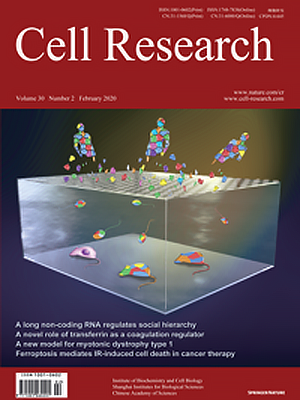
Volume 30, No 2, Feb 2020
ISSN: 1001-0602
EISSN: 1748-7838 2018
impact factor 17.848*
(Clarivate Analytics, 2019)
Volume 30 Issue 2, February 2020: 185-187
LETTERS TO THE EDITOR
Structural basis of a Tn7-like transposase recruitment and DNA loading to CRISPR-Cas surveillance complex
Beibei Wang1, Wenhao Xu1 and Hui Yang1
1State Key Laboratory of Molecular Biology, CAS Center for Excellence in Molecular Cell Science, Shanghai Institute of Biochemistry and Cell Biology, Chinese Academy of Sciences, University of Chinese Academy of Sciences, Shanghai 200031, China
Correspondence: Hui Yang (yanghui@sibcb.ac.cn)
Dear Editor,
Clustered Regularly Interspaced Short Palindromic Repeats (CRISPR) and CRISPR-associated (Cas) systems confer RNA-guided adaptive immunity against invading genetic elements in prokaryotic cells.1 These systems employ CRISPR RNA (crRNA) containing surveillance complexes for sequence-specific recognition and degradation of foreign DNA or RNA. Several nuclease-deficient type I-F, I-B, and V-K systems have been reported to be evolutionarily and functionally associated with Tn7-like transposons lacking a key gene for DNA targeting, implying a new mode of RNA-guided DNA insertion.2,3 Recent studies characterized CRISPR-associated transposase in type I-F and V-K systems and established genome-wide programmable site-specific DNA transposition in E. coli cells, providing the prospect of genome editing strategy without requirement of double-strand breaks and endogenous DNA repair pathways.4,5 All these CRISPR-associated transposons contain transposase subunits, CRISPR effector, and a CRISPR array. Furthermore, subunit TniQ, a homolog of E. coli TnsD, forms a stable complex with Vibrio cholerae Tn6677 type I-F effector Cascade (also called Csy complex) and plays an essential role during DNA insertion.5
https://doi.org/10.1038/s41422-020-0274-0
FULL TEXT | PDF
Browse 853


